August Diagnostic Lab Preview
Problems we begin to see this month
Through August and September, we still see many samples with anthracnose (on oak, aucuba, hydrangea, maple, and others) and spider mites on a variety of vegetable and ornamental plants. We also may see more samples with Japanese beetle damage, black spot on roses, early blight on tomatoes, English boxwood decline, plants with leaf scorch from sun and heat, powdery mildew, euonymus scale, and white peach scale.
In this report we focus on a few new problems that clients start noticing this late in the summer.
These reports are prepared for use at plant clinics by Master Gardeners. They are republished here to assist experienced gardeners in identifying and treating plant problems. Please remember to refer only to the Virginia Cooperative Extension Pest Management Guide for pesticide recommendations.
Cercospora Leaf Spot
 Various Cercospora species cause fungal leaf spots on a variety of plants, including trees, shrubs, herbaceous ornamentals, and vegetables. Our samples are mostly hydrangea and peony. In the home landscape, this disease is primarily an esthetic problem on deciduous plants, as it occurs late in the summer, usually affects only a small portion of the plant’s total leaf surface, and is rarely fatal.
Various Cercospora species cause fungal leaf spots on a variety of plants, including trees, shrubs, herbaceous ornamentals, and vegetables. Our samples are mostly hydrangea and peony. In the home landscape, this disease is primarily an esthetic problem on deciduous plants, as it occurs late in the summer, usually affects only a small portion of the plant’s total leaf surface, and is rarely fatal.
The disease first appears as small purple leaf spots on the upper surface of the leaf. Spots then enlarge up to about 1/4″ to 1/2″, developing a tan to gray center with a purple or brown halo. Under magnification, fungal fruiting structures may be seen in the tan areas. They are dark but may look white due to their silvery, hair-like spores. Heavily spotted leaves turn a yellow-green color and may drop early.
Control Recommendations
Infection can be limited by following good cultural practices to minimize the time foliage is wet. Avoid unnecessarily wetting foliage when irrigating and provide good air circulation to facilitate evaporation of moisture from leaf surfaces.
Collect, bag and dispose of fallen leaves to minimize re-infection and reduce overwintering inoculum. Fungicide treatments are suggested only on plants that incur significant damage every year. Apply at the first evidence of disease symptoms and follow directions on the label for repeat intervals. (For honeylocust, apply at bud break)
The Pest Management Guide general chemical recommendations for control of Cercospora leaf spots on vegetables are found in Table 2.4. Recommendations for ornamentals are found in Table 4.1 (page 4-9) in the long list of fungal diseases and more specifically in Table 4.2 for honeylocust.
More Information
• Cercospora Leaf Spot of Hydrangea, University of Arkansas Cooperative Extension FSA7570
• Cercospora Leaf Spot, (on beets and chard), Cornell University Long Island Horticultural Research and
Extension Center document
Peach Scab
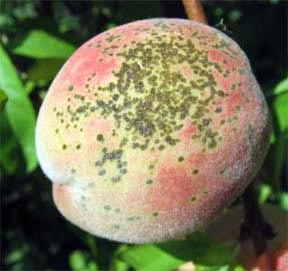 Peach Scab is caused by the fungus Cladosporium carpophilum and is a fairly common problem of peaches and nectarines.
Peach Scab is caused by the fungus Cladosporium carpophilum and is a fairly common problem of peaches and nectarines.
While it can cause minor leaf spotting, the primary damage is to the fruit. Small olive green spots appear on fruit, usually on the stem end. Spots enlarge and darken. The spots become corky, preventing the skin from expanding as the fruit grows, creating openings for other fungal infections. Under the scabs, fruit will also be corky, but damage is shallow. The fungus overwinters in stem lesions.
Control Recommendations
This disease doesn’t develop symptoms for 40 – 70 days after infection. Controls need to be applied just before blossoms open in early spring and repeated several times. While the tree is dormant, prune to remove worst infected twigs and to open up the interior for improved air circulation.
The Pest Management Guide discusses peach scab in the section titled, “Home Fruit: Diseases and Insects” with control recommendations and spray schedules.
More Information
Peach Disease – Scab, Penn State Extension
Peach Diseases, Clemson University Extension
Phytophthora on Herbaceous Ornamentals
In addition to root rots and stem dieback on woody plants, different Phythophthora species can also affect some popular herbaceous plants. In recent years we have received several liriope samples with leaf and crown rot and annual vinca (Catharansus roseus) with stem blight and/or root and collar rot. Phytophthora root and crown rots will also infect snapdragons, petunias, Calibrachoa, and Christmas cactus (Schlumbergera spp.) among many others. Exceptionally wet weather in late spring and early summer provide optimal conditions for these water mold diseases.
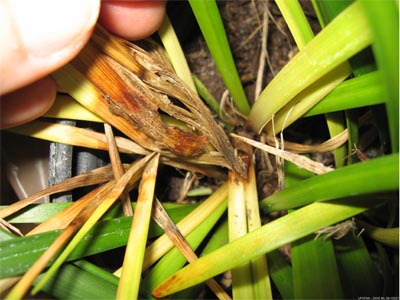
Phytophthora on Liriope
Leaf and crown rot on liriope is caused by Phytophthora palmivora. It can infect any liriope cultivar, though ‘Evergreen Giant’ seems the most susceptible. This disease is spread by water in the soil. Root systems of affected plants are often much-reduced and severely damaged. Infected plants cannot be saved and should be dug out and destroyed.
Phytophthora on Annual Vinca
Annual vinca can get an aerial stem blight (i.e., an infection on parts of the plant above the ground) and a root and collar rot, both caused by Phytophthora species (primarily P. nicotianae, sometimes cited as P. parasitica var. nicotianae).

Vinca stem blight begins with wilting, yellowing leaves, which turn olive green or brown. Dark brown to black lesions can usually be seen on affected stems below the wilting foliage.
We briefly mentioned this problem in our July Preview, but the majority of samples with these diseases have come in August and September. The aerial stem blight begins on the stems and is encouraged by wet foliage. Plants with stem blight sometimes also have the root and collar rot, which starts in the roots and is encouraged by wet soil.
If only individual stems are affected, the plant has the aerial stem blight. Infected stems should be cut out at the base and the remainder of the plant can continue to grow and recover. Treat remaining plants with a foliar spray to help protect the healthy leaves and stems from infection. If the entire plant is wilting severely, it has root rot and likely cannot be saved. Those plants should be removed and destroyed.

With root rot, disease organisms move up the roots to clog the vascular system at the base (or collar) of the plant, choking off the flow of moisture to the stems. Leaves wilt and brown starting at the bottom of the stem.
Control Recommendations
Liriope and annual vinca are both drought-tolerant plants that need good drainage. Adding organic materials to the soil when planting will help improve soil structure and drainage. When planting and mulching liriope, make sure the crown is not buried. Diverting surface runoff and irrigation away from these beds may also reduce the root rot problem.
For these root rot diseases, the causal organism remains in the soil, so the bed should not be replanted with more of the same plants. For alternatives, see North Carolina Cooperative Extension publication “Suggested Plant Species for Sites with a History of Phytophthora Root or Crown Rot.” There are soil drenches that can control root rots caused by water molds (also known as oomycetes) such as Phytopthera, but they do not eradicate the pathogen. Their use is not very practical in the home landscape as they must be regularly reapplied to continue to suppress the disease. PMG control recommendations for Phytophthora root rots and Phytophthora blights on ornamentals are found in Table 4.1 under Oomyceteous diseases.
More Information
• Aerial Stem Blight, Clemson University
• Stem Rot of Annual Vinca, University of Arkansas Extension publication FSA7545
Septoria Leaf Spot on Trees and Shrubs

Septoria leaf spot on dogwood
In earlier Monthly Previews, we have talked about Septoria diseases on rudbeckia (May) and tomatoes (June). There are also Septoria leaf spot fungi that cause leaf spots on a number of woody plants later in the summer. Most of our samples have been dogwoods.
Septoria leaf spot initially appears as dark brownish purple leaf spots often with gray centers. Under magnification, black dots (fungal fruiting bodies) can be seen in the centers of the spots.
On dogwoods, spots are larger than spot anthracnose, typically 1/4″ across. They are irregular or squared shaped (often bound by leaf veins). Spots can coalesce into larger blotches.
Control Recommendations
Because the most severe symptoms of Septoria leaf spot typically occur late in the season when leaves are beginning to fall off naturally, control is typically unnecessary for most species. Removing fallen leaves may help reduce the amount of fungal inoculum available for infection the following season. Controls should be considered only where infection is severe and the plant has suffered significant early leaf loss in previous years.
The Pest Management Guide recommendations for control of Septoria leaf spots on woody ornamentals are found in Table 4.1 (page 4-9) in the long list of fungal diseases and more specifically for dogwoods in Table 4.2.
More Information
Dogwood Diseases and Insect Pests, Clemson University Extension
Three Dogwood Diseases, University of Illinois
Stink BugsThere are several species of stink bugs in our area, including the brown stink bug, green stink bug, Southern green stink bug, and the brown marmorated stink bug (BMSB). Stink bugs feed mainly on fruits and fruiting vegetables, but also on foliage and stems. The most damaging in the home landscape is the recently introduced BMSB. In addition to feeding damage, in the fall it becomes a nuisance pest, aggregating on structures, seeking a place to overwinter. For our purposes it is not necessary to distinguish between various species of stink bugs, but we do want to distinguish them from the spined soldier bug, which is a beneficial predator. Keys to identifying the spined soldier bug:
Control Recommendations |
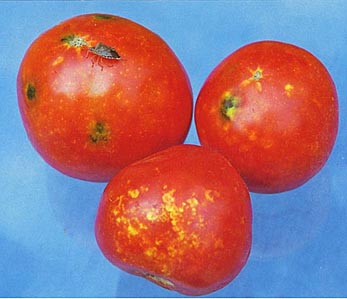 Stinkbug damage on tomatoes are small dark pin pricks surrounded by white or yellow tissue. Wounds allow fungal infections entry. 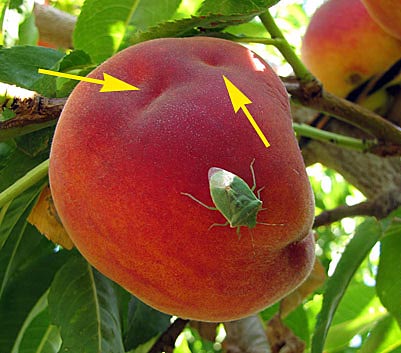 Stink bug damage on peaches causes dimples (cat facing) as fruit develops. This injury sometimes leads to splitting and fungal infection. Peaches sometimes respond extruding a clear gummy substance. 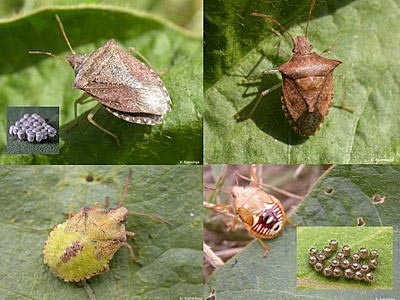 BMSB & eggs on the left; beneficial spined soldier bug & eggs on the right |
More Information
• Brown Marmorated Stink Bug, Virginia Cooperative Extension
• Brown Stink Bug, University of Florida IFAS page (with life cycle photos)
• Spined Soldier Bug, University of Florida IFAS page (with life cycle photos)